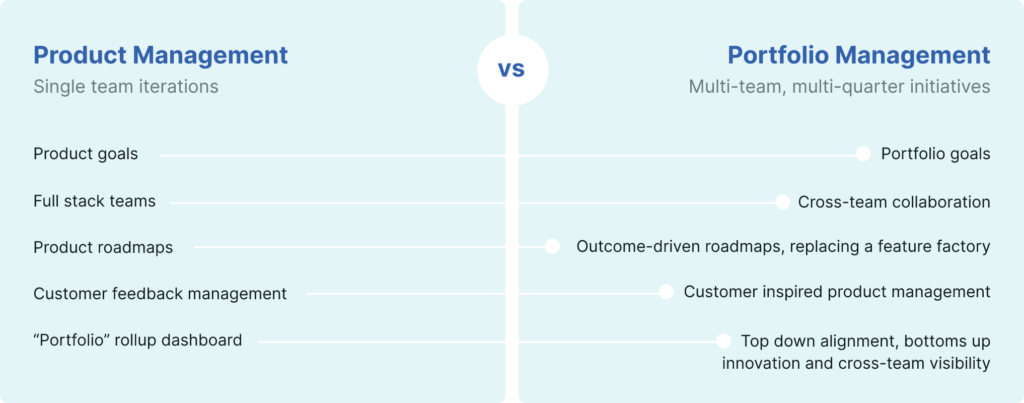We’ve observed a puzzling paradox—great product managers exist at market-leading and market-losing companies. So what does it take to build a high-performing product organization that propels companies to wild success? The answer is Product Portfolio Management (PPM).
In this post, we’ll look at the definition of product portfolio management, its evolution, its relationship with product management, and the key elements.
What is Product Portfolio Management?
Product Portfolio Management is the practice of aligning an organization’s product portfolio with its business strategies to achieve profitability. It involves evaluating product performance, identifying risks and opportunities, prioritizing high-value products, and optimizing resources. That lets you make informed tradeoff decisions and balance the product mix among strategic buckets.
Product portfolio management borrows principles of portfolio management from the finance world:
“Portfolio management is the art and science of selecting and overseeing a group of investments that meet the long-term financial objectives and risk tolerance of a client, a company, or an institution.”
Investopedia
Besides making the best investment decisions, winning portfolio management includes:
- Allocation to various categories of investments to maximize portfolio yield.
- Periodic allocation adjustments based on the goals, performance, and markets.
A successful product organization operates the same. It uses a portfolio approach to evaluate product categories and allocate resources to maximize business outcomes. In addition, it is responsive and adaptive to fast-changing market trends and business needs.
Next, let’s look at the history of portfolio management to understand how we arrived at the newest evolution—Responsive Product Portfolio Management (PPM).
The Journey to Responsive Product Portfolio Management
Traditionally, product organizations ran Portfolio Management, which considers each product line an investment option. For example, the Proctor and Gamble baby care portfolio comprises shampoos, powders, and diapers.
When IT came along, the product line became intangible. But, the need remained to allocate resources (e.g., engineers) to best support customers. That led to Project Portfolio Management, defined as:
“The centralized management of one or more portfolios, and involves identifying, prioritizing, authorizing, managing, and controlling projects, programs, and other related work, to achieve specific strategic business objectives.”
Project Management Institute (PMI)
Project Portfolio Management fits well in a waterfall-type environment. However, this approach became a struggle as digital products grew more complex. Digital products, like Google Search, often appear as a single product from the customer’s perspective. But the product organization for Google Search has many product teams with their own underlying “product areas.” It is a “one-product portfolio.”
In this structure, product portfolio managers face many questions. How do you define categories for product investments when there are no easily separable product lines? How do you evaluate and decide which part of Google Search to focus on? Where should you increase or reduce investment?
With the adoption of agile product development, Project Portfolio Management, with its pre-defined, fixed-scoped projects, no longer worked.
In agile, engineering teams work collaboratively with product managers to design better ways to solve customer problems. However, if product managers start working with engineers on all ideas, all the time, across teams, it can become very chaotic and confusing.
These were the “new” challenges we faced 15 years ago at PayPal during its Agile transformation. So we created a new product portfolio management practice to support multidimensional digital products in an agile world.
This practice is called Responsive Product Portfolio Management (Responsive PPM).
Traditional Portfolio Management vs. Project Portfolio Management vs. Responsive Product Portfolio Management

How is Product Portfolio Management Different Than Product Management?
Now, you may wonder, “How does portfolio management interact with product management, and how do the two differ?”
Product management sparks innovation and problem-solving at the level of the customer’s need. In contrast, portfolio management ensures strategic alignment and resource allocation to maximize portfolio outcomes.
Core product management skills include analyzing customer needs, product discovery, design, planning, iterating, and releasing new product features. Portfolio management skills include strategic planning, forecasting, resource allocation, trade-off analysis, scenario planning, and adjustment.

Can Small Orgs and Individual Product Managers Do Product Portfolio Management?
Can a Product Manager apply a Responsive PPM approach, even if they don’t have control of the company’s entire portfolio of products?
Absolutely!
Product portfolio management involves managing complexity and delivering the best product outcomes given constraints. Product Managers find themselves doing this already, every day.
Every product manager leads a portfolio since their product or product area needs to support several goals, multiple segments, and various themes. The emphasis is not on managing the size of your portfolio but on managing your choices.
Watch the Webinar Recording: Replace Your Roadmap with a Responsive Portfolio to Drive Outcomes
Key Elements of Product Portfolio Management
Now that we’ve covered the different iterations of product portfolio management and how it relates to product management, let’s break it down to see what is involved.
Product Roadmapping
A roadmap is a visualization of the vision, priorities, timelines, and work required to meet your goals. Roadmapping helps you communicate your plans to stakeholders and track progress.
Before building a roadmap, you must collect and organize customer insights. These could be internal ideas or direct feedback from customers. If you’re doing a feature-based roadmap, you would work from this backlog of requests and choose which feature to prioritize for a single outcome. However, with outcome-focused roadmapping, product teams can take a more holistic approach to prioritizing features that will drive the best outcomes while considering all the dimensions of the business, customer, and portfolio.
Remember, customizing your roadmap based on your audience and showcasing varying details is crucial. Indeed, this is the last step of any great roadmap—sharing it!
Present the data in a way that quickly aligns everyone involved and communicates the plan. For example, C-level executives likely want to know if your roadmap is on track and meeting OKRs. On the other hand, a weekly sync with the product team must highlight the details of each Epic, visualize dependencies, show progress percentages, and display statuses. These are two very different roadmaps, but both are equally important.
Portfolio Management
In addition to the PMs’ focus on their individual roadmaps, product leaders and product ops need to align and manage the entire portfolio—multiple products and their dependencies. To do this successfully, connect your long-term vision with team execution. The most successful product-centric companies do this by starting with corporate-wide business goals and identifying where to invest resources to achieve meaningful results.
Next, set objectives that span multiple business areas and link them to the corporate strategy. You can even connect objectives and key results (OKRs) to your initiatives and roadmaps. By linking these, you prioritize initiatives for the relevant OKRs based on how much they contribute to each objective.
During this step, you’ll want to anticipate trade-offs to understand the opportunity cost of prioritization decisions. Roadmaps cover the what and when, but it’s vital also to include the “how” and “what-if” scenarios during resource allocation so you can respond to the inevitable changes driven by the market.
This framework is how outcome-driven organizations operate. It becomes an internal pulse and guides teams to prioritize what to build next while keeping everyone aligned through planning, resourcing, and progress tracking.
Some organizations also like to analyze existing product portfolios using frameworks like the Boston Consulting Group’s Growth Share Matrix or GE/McKinsey Matrix. The BCG Matrix organizes products based on their relative market share and growth rate into four categories, with “cash cows” being products with low growth but high market share. In contrast, the GE/McKinsey Matrix looks at the competitive strength of the business unit compared to industry attractiveness.
Outcome Delivery
The key to delivering outcomes is to ensure your strategy aligns with the company’s overarching goals. Outcome-driven teams constantly decide where to focus, choosing the features that will provide the most impact and greatest outcome. They prioritize and re-prioritize diligently to keep their work connected to the near-term focus and long-term vision.
Today’s industry-leading organizations allocate resources between multiple dimensions, outcomes, and timeframes. They apply the rock, pebble, and sand technique to best manage their company’s product portfolio. In doing so, they can also move forward with their big, strategic bets and continue to innovate and transform.
The last element to delivering outcomes is continuously evaluating progress toward your goals and responsively adjusting. For example, you should adapt if the team is over-achieving in one goal and underperforming in another. No need to wait for the next “planning cycle” to make a change. That is the beauty of outcome-driven product management—the ability to respond, adjust in real-time and keep every effort focused on your goals.
The Benefits of a Responsive Product Portfolio Management Approach
Product portfolio management is the product-centric company’s key to combating chaos, misalignment, dependencies, resource bottlenecks, and other growing pains.
While there are a few “flavors” of PPM, we recommend following the Responsive PPM approach:
- Produce outcome-driven initiatives that are iteratively built, tested, and learned from or validated before the next iteration.
- Encourage a bottom-up workflow that empowers teams and leaders to make iterative and holistic decisions toward achieving their OKRs.
- Allow executives to adjust and reprioritize in response to changes in execution, available resources, and external factors.
- Tie the strategic and execution cycles to the rhythm of “Align, Allocate, and Adjust,” ensuring everyone moves in the right direction and speed.
Rather than planning only once a year, Responsive PPM is the rallying drumbeat for an entire organization. Responsive PPM lets agile, product-centric organizations maintain agility regardless of size and scale.
Are you interested in learning more? Then, join the fastest-growing community for product portfolio management and connect with industry colleagues at ResponsivePPM.org.




